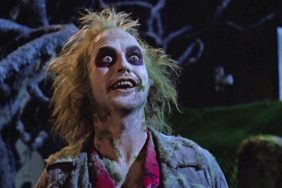When it comes to the subject of witches, storytellers like to have it both ways. On one hand, telling the literal story of magic-wielding individuals, be they heroic or villainous, is an intensely cinematic idea. On the other hand, the very real, very sobering concept of “witch hunts” means that these beings of immense power can also be portrayed as martyrs, whether they wielded actual supernatural powers or not.
To that end there are an awful lot of movies about witchcraft that tackle the subject from all possible angles, from the goofy nostalgia classic Hocus Pocus to this weekend’s disturbing new film The Witch, about an isolated colonial family falling prey to religious fervor and interpersonal strife (and who may be using witchcraft as a scapegoat, or may actually be afflicted by Satan’s influence).
Also: Now Streaming | Five Great Horror Films Directed by Women
But what, dear readers is the best witchcraft movie ever? We wanted to find out, so we asked our panel of film critics – Crave’s William Bibbiani and Witney Seibold, and Collider’s Brian Formo – to present their individual picks. They can only pick one film a piece, and this time two of them picked the same film, meaning that we have at least narrowed the contenders down more than usual.
Find out which bewitching films they picked, and come back every Wednesday for an all-new, highly debatable installment of Crave’s The Best Movie Ever!
Brian Formo’s Pick: Häxan: Witchcraft Through the Ages (1922)

The Criterion Collection
The inability to explain religious superstitions in court systems—of devils and demons possessing livestock, or compelling people to steal, for example—created the human Witch in Benjamin Christensen’s curious film Häxan: Witchcraft Through the Ages. With Robert Eggers’ The Witch (which is an excellent film) recently receiving the Satanic Temple’s endorsement for showing witchcraft as a way to escape patriarchy, Christensen’s early oddity is made even more intriguing for showing how witches essentially replaced demons in what townspeople blamed their superstitions (or outright failures in business) on.
Christensen’s part-documentary, part-folk artwork re-enactment, part-beatnik film (Häxan was re-released with narration by William S. Burroughs and an acid jazz score) is mostly concerned with how narratives of possession change throughout decades, and how those narratives are routinely used to overpower women who don’t follow Christian rules. His film itself has no narrative to speak of, but it was hugely influential because it was the first (known) film to use re-enactments in a documentary. And since this is witchcraft, the re-enactments of testimony are rather salacious, particularly for a film shot in 1921. There’s some nudity and lots of Satan cameos (played by Christensen himself).
What’s great about Häxan is that Christensen recreates the scenarios exactly how the drawings from the Middle Ages through Puritan hysteria represent them. His devil is a red, bare-chested, flapping-tongued devil. His devil rises up to snatch nude maidens and religious nuns in Haxan. And since it’s a moving image, it looks even more ridiculous than the old drawings of town’s people saying this is what came to them when in the presence of a woman they accused of being a witch. A mockery of new systems of justice was made with witchcraft accusations, and Christensen ends by saying a mockery of public health institutions that replaced it.
Witney Seibold’s Pick: Häxan: Witchcraft Through the Ages (1922)

The Criterion Collection
The 1922 Danish film Häxan (English title: Witchcraft Through the Ages) written and directed by Benjamin Christiansen, gets to have its cake and eat it too. Ostensibly, it is a case study about how paranoia, local superstitions, mass hysteria, and a general misunderstanding of certain mental illnesses was what has, historically, led to the belief in – and persecution of – witches throughout the Western world. The film acts as a counterpoint argument to an infamous 1486 treatise called The Malleus Maleficarum written by an ousted monk about how real witches were, and what a danger they posed to people. The film claims that it wants to put an end to superstition, and poses as a call for healthy skepticism. It also posits that we now live in a more enlightened time.
But Häxan is not is considered a cinematic classic for its call to logic or for its thesis. Indeed, film scholars and film fans are drawn to it for its eerie ability to make witchcraft seem palpable and real. The film is staged as a documentary, but extended portions of Häxan are elaborate staged recreations of Satanic rites and witchcraft in action. Christiansen himself appears as Satan, and the whole of the film plays out like a legitimate horror movie. None of this is real, the film says, but look how real it is. When it comes to truly frightening depictions of witch-based horror, one cannot get better than the so called “fake” scenes in Häxan.
Also, I’ve seen all 13 films in Witchcraft series, a string of cheap, lurid, softcore horror movies loaded with bare breasts and bad dialogue. This has nothing to do with the above, but it’s something I’ve earned the right to brag about.
William Bibbiani’s Pick: Witchfinder General (1968)

American International Productions
Witches are an enormous bag of worms, thematically speaking. Over the years they have represented actual demons, metaphoric demons, political conspiracies, misogynistic men and empowered women and everything in between. Depending on your own personal views, a fairy tale film like The Witches might be “the best witchcraft movie ever.” Or a feminist thriller like The Craft could do the trick. Or maybe film about hysteria, like The Blair Witch Project, deserves the title.
Personally, I look at the history of witchcraft and see a series of brutal persecutions, and it seems as though filmmaker Michael Reeves agreed with me. His 1968 drama Witchfinder General is about a shyster in the mid-17th century who traveled from town to town, torturing and executing witches for profit. Played by Vincent Price, whose characteristic smarminess never seemed scarier, the “witchfinder general” of the title openly admits, to his co-conspirator at least, that witchcraft is a sham.
Heck, even those who employ his services usually speak of the occult as if it were an awkward euphemism. Everybody knows what’s really going on here, and that makes the witch hunt that much more despicable. The mob in The Crucible seems genuinely duped in comparison to the disgusting characters in Witchfinder General. There’s a plot about a soldier racing home to save his accused lover, but Reeves prefers to revel in the day to day gruesomeness involved in monetizing oppression, under thin disguise of social consciousness.
But there are many other interpretations of witchcraft, both literal and allegorical, and depending on your point of view they may be all the more valid. Regardless, see this movie. I maintain it’s “the best witchcraft movie ever,” from a certain point of view.
Previously on The Best Movie Ever:
Top Photo: The Criterion Collection / American International Pictures
The Best Movie Ever
-
The Best Movie Ever | Under the Sea

Is the best movie ever set underwater a family film about a fish or a World War II movie about a German submarine?
Photos: Disney / Pixar / Neue Constantin Film
-
The Best Movie Ever | Video Game Adaptations

There aren't a lot of good video game adaptations, and our critics just can't agree on which one is the best.
Photos: Universal Pictures / New Line Cinema / Dimension Films
-
The Best Movie Ever | Reptiles

Movies about slithery things aren't very common, so our critics are presenting their picks for the best reptile movies ever.
Photo: Warner Bros. / Paramount Pictures / New Line Cinema
-
The Best Movie Ever | Helena Bonham Carter

Is Helena Bonham Carter's best movie a classy costume drama or a twisted critique of contemporary masculinity?
Photo: Fine Line Features / Miramax Films / 20th Century Fox
-
The Best Movie Ever | Crime Comedies

What's the best comedy ever made about living a life of crime? Our critics present their picks.
Photo: MGM / Warner Bros. / Janus Films
-
The Best Movie Ever | Jodie Foster

The Oscar-winning actor/director is one of the most respected artists in the film industry. But what's her best movie ever?
Photo: Columbia Pictures / Warner Bros. / MGM Home Entertainment
-
The Best Movie Ever | Robert Downey Jr.

The man who would be Iron Man has had one of the most unusual careers in film history, but which movie is his best?
Photo: Warner Bros. Pictures / Paramount Pictures
-
The Best Movie Ever | Cats

Keanu may be a great comedy about a cat, but what's the best cat movie ever? Our critics picked some WEIRD films this week!
Photo: Drafthouse Films / United Artists / Kindai Eiga Kyokai
-
The Best Movie Ever | Charlize Theron

Is Charlize Theron's best movie the one that earned her an Oscar, or the one that kicked ass?
Photo: Warner Bros. / Newmarket Films
-
The Best Movie Ever | Ice Cube

It's been 25 years since Ice Cube made his acting debut. So what's his best movie ever?
Photo: Miramax Films / New Line Cinema / Universal Pictures
-
The Best Movie Ever | Dreams

What's the best movie ever made about dreams, dreaming or dreaminess? Our critics present their picks.
Photo: Films du Losange / Criterion / Fox Searchlight
-
The Best Movie Ever | Batman

Everybody loves Batman, but what's the best Batman movie ever? Our critics can't agree in this week's roundup.
Photo: 20th Century Fox / Warner Bros.
-
The Best Movie Ever | Superman

Batman v Superman isn't the best Superman movie ever, so we asked our stable of critics to decide which one is.
Photo: Warner Bros.
-
The Best Movie Ever | Justice

Let's celebrate this exciting new Dawn of Justice with a spirited debate about the best movie ever made about justice itself.
Photo: Koch-Lorber / 20th Century Fox / United Artists
-
The Best Movie Ever | John Goodman

The star of 10 Cloverfield Lane has had an astounding career, but what's his best movie ever?
Photo: Gramercy Pictures / 20th Century Fox
-
The Best Movie Ever | Die Hard Ripoffs

Die Hard spawned a whole genre of action movies that live on to this day, but which Die Hard ripoff is the best?
Photo: 20th Century Fox / Columbia Pictures / Golden Princess Film Production
-
The Best Movie Ever | Oscar Bait

'Oscar bait' isn't an insult, it's a genre. So what's the best Oscar bait movie ever?
Photo: The Weinstein Company / Universal Pictures
-
The Best Movie Ever | Witchcraft

What's the most bewitching movie ever made about witches? Our panel of critics narrows it down to two classic films.
Photo: Criterion / American International
-
The Best Movie Ever | Action Comedies

If Deadpool isn't the best action comedy ever, what is? Our panel of film critics make the case for their favorites.
Top Photo: Warner Bros. / RM Films International / 20th Century Fox
-
The Best Movie Ever | George Clooney

Everyone loves George Clooney, but none of our critics can agree on which film qualifies as his very best.
Photo: Buena Vista / Universal / Warner Bros.
-
The Best Movie Ever | Martial Arts

Our panel of critics fights over their picks for the best martial arts movie ever made. There can be only one!
Top Photo: Shaw Bros. / Warner Bros. / Toho
-
The Best Movie Ever | Creepy Dolls

Everyone's frightened of little toy people, but what's the creepiest creepy doll movie ever?
Top Photo: Universal Pictures / United Artists / New World Pictures
-
The Best Movie Ever | Modern Warfare

If 13 Hours isn't the best movie about our contemporary wars, what is? Our panel of critics weighs in.
Photo: Warner Bros./Columbia Pictures/Summit Entertainment
-
The Best Movie Ever | Revenge

If The Revenant isn't the greatest revenge movie, what is? Our film critics nominate some of the best films ever made.
Top Photos: Janus Films / Paramount Pictures / Tartan Films
-
The Best Movie Ever | Parties

We asked our critics to pick the best party movie ever made, and none of them picked a film about a frat house.
Photo: Warner Bros. / 20th Century Fox / Sony Pictures Classics
-
The Best Movie Ever | Quentin Tarantino

Is the Hateful Eight director's best film an autumnal romance or a World War II drama? Our critics can't decide.
Photos: The Weinstein Company / Miramax
-
The Best Movie Ever | Star Wars

Is A New Hope better than The Empire Strikes Back? Our critics debate the classics (and ignore the rest).
Photos: Disney / LucasFilm
-
The Best Movie Ever | Ron Howard

He's directed films in nearly every genre and won an Oscar for his troubles, but what's the best Ron Howard movie ever?
Photo: Touchstone / Universal / MGM
-
The Best Movie Ever | William Shakespeare

He's the most adapted author in movie history, but which William Shakespeare movie is the very best?
Photo: Top Photos: Toho / Paramount / Columbia
-
The Best Movie Ever | Pixar

Everyone has their favorite Pixar movie, but which one is the best?
Photo: Disney
-
The Best Movie Ever | Young Adult

Before you say goodbye to The Hunger Games, find out what our critics think was the best young adult movie ever.
Photo: Universal Pictures / Warner Bros.
-
The Best Movie Ever | Angelina Jolie

She's been acting for decades, directing for years, and winning our admiration forever. But what is Angelina Jolie's best film ever?
Photo: The Samuel Goldwyn Company / HBO / Columbia Pictures
-
The Best Movie Ever | James Bond

It's new school versus old school! Our critics debate which film qualifies as the best Bond movie ever.
Photo: MGM / Colombia Pictures / United Artists
-
The Best Movie Ever | Sandra Bullock

Our critics can only agree on one thing: the best Sandra Bullock movie isn't the one that got her an Oscar.
Photo: 20th Century Fox / Warner Bros.








